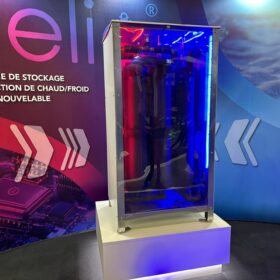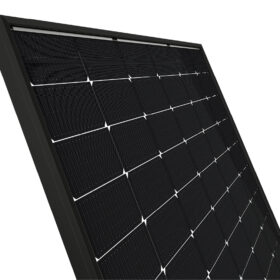FHE Group presents thermal battery for solar power storage
The French company says its Inelio thermal battery can store solar power in the form of heat for heating and cooling applications, as well as for producing domestic hot water, while maximizing self-consumption. It can reportedly provide a hot water temperature of up to 65 C.
Perovskite-silicon tandem solar cell based on wide-bandgap top device achieves 33.10% efficiency
Researchers in China have integrated a wide-bandgap perovskite solar cell with a hybrid back contact device in a four-terminal tandem cell that achieves high efficiency and stability. Key for the strong performance was a new surface passivation strategy that the research group adopted for the top cell.
Combining floating PV with compressed air energy storage
Researchers from Egypt and the UK developed a new floating PV system concept that utilizes compressed air for energy storage. The system has a roundtrip efficiency of 34.1% and an exergy efficiency of 41%.
Norway defining new rules for energy communities
The Norwegian government says it is creating a new regulatory framework for energy communities. The new provisions will allow PV systems up to 5 MW in size to sell power and share surplus energy within specific industrial areas.
JinkoSolar sues VSUN for alleged patent infringement
China-based panel maker JinkoSolar says that its competitor VSUN and its related entities in the United States have infringed on one of its patents.
What happens when fire hits PV systems deployed on sloped roofs
An international research team has observed how fire propagates in PV systems installed on flat roofs and has found that a certain amount of energy is needed for a fire to start and propagate in the cavity below the solar panels.
Taiwan launches $126 million rebate program for small rooftop PV
Taiwan’s Ministry of Economic Affairs (MoEA) says it will offer up to TWD 300,000 ($9,260) per project through a $126 million rebate program for small rooftop PV systems, with eligibility limited to systems not exceeding 3 kW.
Researchers claim record-breaking 25.7% efficency for perovskite-organic tandem solar cell
Conceived by a research team from Germany’s University of Potsdam and the Chinese Academy of Sciences, the tandem cell is based on a wide-bandgap perovskite bottom cell and a narrow-bandgap organic top device. The researchers used a compound known as cyclohexane 1,4-diammonium diiodide for suface passivation.
How to combine off-grid agrivoltaics with large-scale hydrogen production
Scientists in the United Kingdom have simulated how a 1 GW off-grid agrivoltaic facility may be used to fuel hydrogen fuel electric cell vehicles across Australia, California, China, Nigeria, and Spain. Their techno-economic analysis showed that the proposed combination could provide a levelized cost of hydrogen ranging from $3.90/kg to $8.13/kg.
Fraunhofer ISE, AMOLF unveil TOPCon solar cell based on metal nanowire grid front electrodes
The two research institutes used silver nanowire grids as an alternative to indium tin oxide for the cell’s transparent electrodes. They claim this is the first time that a metallic nanostructure offers photonic gain in a solar cell.











